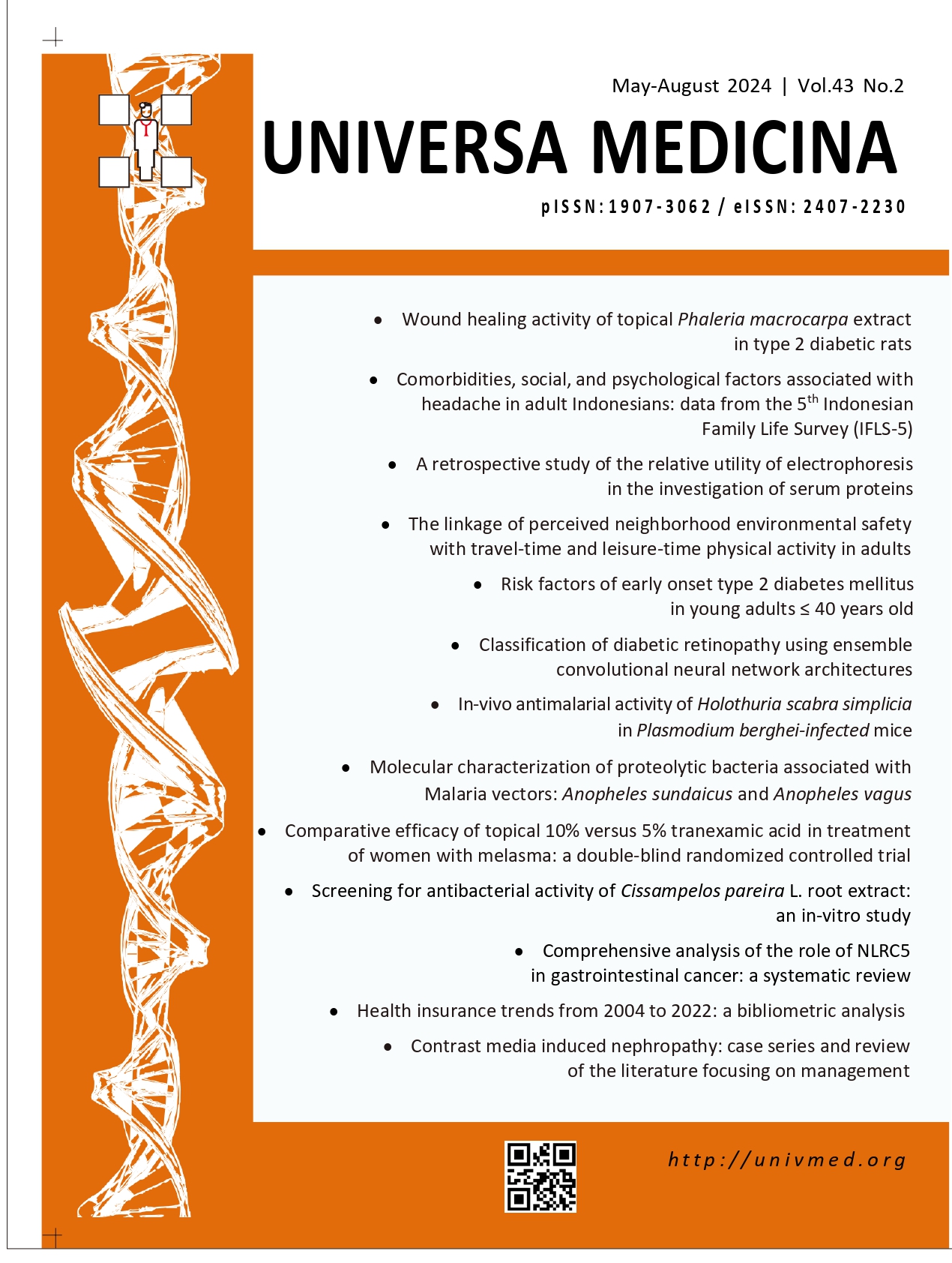Screening for antibacterial activity of Cissampelos pareira L. root extract: an in-vitro study
Main Article Content
Abstract
Background
The recurrence of antibacterial infections after antibiotic treatment necessitates the investigation of alternative therapies against uropathogens. Cissampelos pareira is an Ethiopian medicinal plant that has been used for centuries by traditional healers to treat various diseases. The plant is selected on the basis of its traditional use in treating urinary tract infections by the local community. The objective of this study was to determine traditionally used anti-uropathogenic properties of C. pareira root extracts.
Methods
C. pareira plant roots collected from Pawe Woreda were shade-dried, powdered, and extracted using chloroform, hexane, acetone, methanol, and ethanol, respectively. The antibacterial activities with different concentrations of the crude extracts were determined using the disc diffusion assay. The minimum inhibitory concentration (MIC) and minimum bactericidal concentration (MBC) of the crude extracts were determined using a two-fold broth dilution method.
Results
The antibacterial activities of the root extracts against tested organisms as shown by inhibition zone diameters ranged from 7.0±0.1 to 20.8±1.0 mm. The highest inhibition was recorded from the ethanol extract while the lowest was from the chloroform extract. The MIC and MBC values ranged from 12.5 to 50 µg/mL and 25 to 100 µg/mL, respectively. Ethanolic and methanolic C. pareira root extracts showed the presence of antibacterial compounds (alkaloids, flavonoids, tannins, terpenoids and steroids).
Conclusion
This study showed that C. pareira root serves as a potential source for developing new antibacterial drugs against bacteriuria. However, nontoxicity evaluation is recommended for the use of herbals as therapeutic agents in pharmacy.
Article Details
Issue
Section

This work is licensed under a Creative Commons Attribution-NonCommercial-ShareAlike 4.0 International License.
The journal allows the authors to hold the copyright without restrictions and allow the authors to retain publishing rights without restrictions.
How to Cite
References
Girma A, Aemiro A, Workineh D, Tamir D. Magnitude, associated risk factors, and trend comparisons of urinary tract infection among pregnant women and diabetic patients: a systematic review and meta‐analysis. J Pregnancy 2023;2023:8365867. doi: 10.1155/2023/8365867.
Girma A, Aemiro A. The bacterial profile and antimicrobial susceptibility patterns of urinary tract infection patients at Pawe General Hospital, Northwest Ethiopia. Scientifica 2022;2022:3085950. doi: 10.1155/2022/3085950.
Nsofor CA, Obijuru CE, Ozokwor CL. Asymptomatic bacteriuria among female students of a tertiary institution in Southeast Nigeria. EC Bacteriol Virol Res 2016;2:106-12.
Uthpala T, Raveesha HR. Studies on antioxidant and antibacterial activity of Cissampelos pareira (L.). Int J Adv Sci Res Manage 2019;4:35-42.
Elshafie HS, Camele I, Mohamed AA. A comprehensive review on the biological, agricultural and pharmaceutical properties of secondary metabolites based-plant origin. Int J Mol Sci 2023;24:3266. doi: 10.3390/ijms24043266.
Hikal WM, Alhawiti LS, Mahmoud AA, Tkachenko KG, Said-Al Ahl HA. Cissampelos pareira: a potential source of medicine to treat malaria. Int J Mosq Res 2021;8:37-43.
Mukherjee P, Mao A. Compendium of antiviral medicinal plants of North East India. Imphal, Manipur, India: Institute of Bioresources and Sustainable Development; 2021.
Bala M, Kumar S, Pratap K, Verma PK, Padwad Y, Singh B. Bioactive isoquinoline alkaloids from Cissampelos pareira. Nat Prod Res 2019;33:622-7. doi: 10.1080/14786419.2017.1402319.
Kumari S, Bhatt V, Suresh PS, Sharma U. Cissampelos pareira L.: a review of its traditional uses, phytochemistry, and pharmacology. J Ethnopharmacol 2021;274:113850. doi: 10.1016/j.jep.2021.113850.
Muthuselvam D. Antibacterial activity of Cissampelos pareira Linn against certain bacterial strains. World J Pharma Res 2016;5:1439-44. DOI: 10.20959/wjpr20164-5985.
Njeru SN, Obonyo MA, Nyambati SO, Ngari SM. Bioactivity of Cissampelos pareira medicinal plant against Mycobacterium tuberculosis. J Pharma Phytochem 2015;3:167-73.
Woldeab B, Regassa R, Alemu T, Megersa M. Medicinal plants used for treatment of diarrhoeal related diseases in Ethiopia. Evid Based Complement Alternat Med 2018;2018:4630371. doi: 10.1155/2018/4630371.
Andualem Asemahagn M. The functionality status and challenges of electronic health management information system: the case of public health centres in Amhara Region, Ethiopia. Cogent Medicine 2018;5:1437672. https://doi.org/10.1080/2331205X.2018.1437672
Sitotaw B, Ayalew F, Girma A, et al. Isolation and identification of promising antibiotic-producing bacteria. Open Chemistry 2022;20:1283-91. https://doi.org/10.1515/chem-2022-0233
Jorgensen JH, Turnidge JD. Susceptibility test methods: dilution and disk diffusion methods. In: Jorgensen JH, Carroll KC, Funke G, et al. Editors. Manual of clinical microbiology. 11th ed. American Society of Microbiology;2015.pp.1253-73. https://doi.org/10.1128/9781555817381.ch71.
Kassaw E, Yohannes T, Bizualem E. In-vitro antibacterial activity of Plantago lanceolata against some selected standard pathogenic bacterial. Int J Biotechnol 2018;7:44-50. https://doi.org/10.18488/journal.57.2018.71.44.50
Girma A, Aemiro A. Antibacterial activity of lactic acid bacteria isolated from fermented Ethiopian traditional dairy products against food spoilage and pathogenic bacterial strains. J Food Qual 2021;2021:9978561. https://doi.org/10.1155/2021/9978561
Nortjie E, Basitere M, Moyo D, Nyamukamba P. Extraction methods, quantitative and qualitative phytochemical screening of medicinal plants for antimicrobial textiles: a review. Plants (Basel) 2022;11:2011. doi: 10.3390/plants11152011.
Mazzariol A, Bazaj A, Cornaglia G. Multi-drug-resistant Gram-negative bacteria causing urinary tract infections: a review. J Chemother 2017;29(sup1):2-9. doi: 10.1080/1120009X.2017.
Süntar I. Importance of ethnopharmacological studies in drug discovery: role of medicinal plants. Phytochem Rev 2019;19:1199-209.
Shrestha L, Gupta SP. Phytochemical analysis and antibacterial activity of Cissampelos pareira Lin. rhizome extract against some bacterial strain. World J Pharma Pharmaceut Sci 2019;8:1330-42. DOI: 10.20959/wjpps20194-13346.
Li Y, Kong D, Fu Y, Sussman MR, Wu H. The effect of developmental and environmental factors on secondary metabolites in medicinal plants. Plant Physiol Biochem 2020;148:80-9. doi: 10.1016/j.plaphy.2020.01.006.
Gadisa E, Tadesse EJ. Antimicrobial activity of medicinal plants used for urinary tract infections in pastoralist community in Ethiopia. BMC Complement Med Ther 2021;21:74. doi: 10.1186/s12906-021-03249-7.
Oyeyipo OO, Onasoga MF. Antimicrobial potency of hydro, acetone and ethanolic extracts of Treculia africana Decne root and stem bark. J Appl Sci Environ Manage 2015;19:687-93. http://dx.doi.org/10.4314/jasem.v19i4.17.
Arip M, Selvaraja M, Tan LF, et al. Review on plant-based management in combating antimicrobial resistance-mechanistic perspective. Front Pharmacol 2022;13:879495. https://doi.org/10.3389/fphar.2022.879495.
Lobiuc A, Pavăl N-E, Mangalagiu II, et al. Future antimicrobials: natural and functionalized phenolics. Molecules 2023;28:1114. doi: 10.3390/molecules28031114.
Rahman M, Borah M. Phytochemicals: their role and mechanism in suppressing plant pathogenic bacteria. Pharma Innov J 2021;10:466-71. https://doi.org/10.22271/tpi.2021.v10.i6g.6560.


